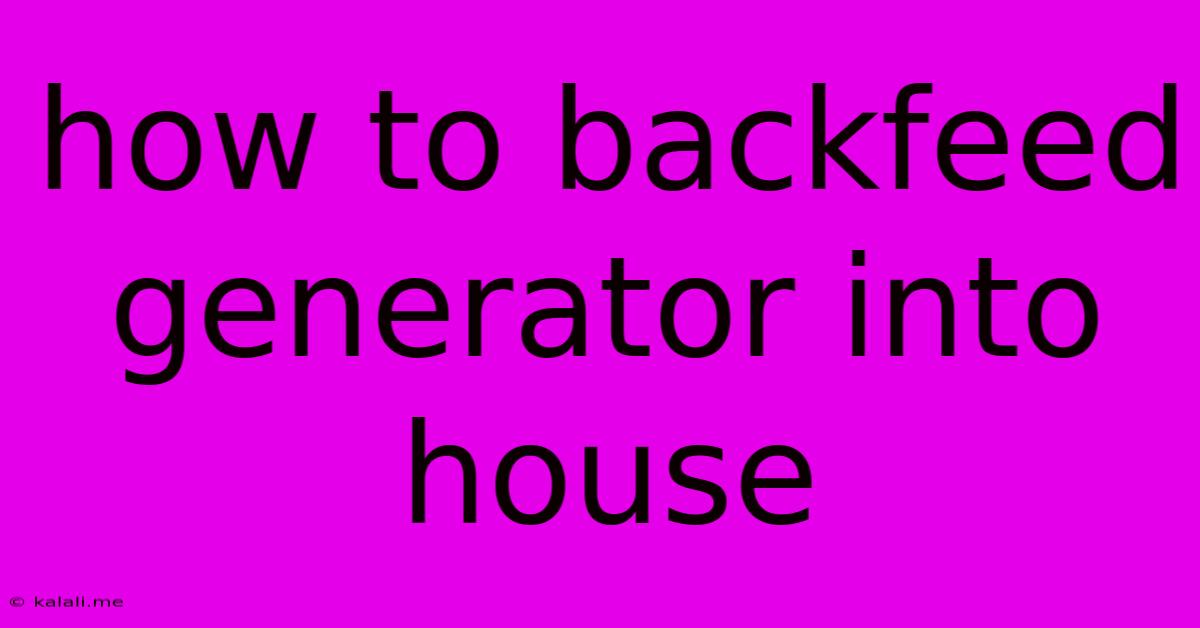How To Backfeed Generator Into House
Kalali
May 25, 2025 · 4 min read

Table of Contents
How to Backfeed a Generator Into Your House: A Comprehensive Guide
This article provides a comprehensive guide on how to safely and effectively backfeed a generator into your house during a power outage. Improper backfeeding can be extremely dangerous and potentially lethal, so it's crucial to understand the process completely before attempting it. This guide is for informational purposes only and should not be considered professional advice. Always consult with a qualified electrician before undertaking any electrical work.
Backfeeding a generator allows you to power essential circuits in your home during a power outage. This is achieved by connecting the generator to your home's electrical system. However, it's vital to prioritize safety to avoid electrocution or damage to your appliances and generator. This guide outlines the safest methods and critical safety precautions.
Understanding the Risks of Backfeeding
Before diving into the how-to, it's essential to understand the inherent dangers:
- Electrocution: Working with electricity is inherently risky. Incorrect wiring can lead to lethal electric shocks.
- Equipment Damage: Backfeeding improperly can damage your generator, appliances, and your home's electrical system.
- Fire Hazards: Overloaded circuits or faulty wiring can easily cause fires.
- Carbon Monoxide Poisoning: Improper ventilation can lead to deadly carbon monoxide buildup from the generator.
Never attempt backfeeding without proper knowledge and safety precautions.
Methods for Backfeeding a Generator
There are two main methods for backfeeding a generator:
1. Using a Transfer Switch: This is the safest and recommended method. A transfer switch is a professionally installed device that safely isolates your home's electrical system from the power grid and connects it to your generator. It prevents backfeeding into the power lines, protecting utility workers and preventing damage to your equipment. This method requires professional installation.
2. Interlock Kit (Less Safe): An interlock kit allows you to disconnect the main breaker and safely connect your generator to a specific circuit. This is a less safe option and should only be considered as a temporary solution and only if undertaken by a qualified electrician. It offers less protection compared to a transfer switch.
Steps for Backfeeding with a Transfer Switch (Safest Method)
Since this is the safest method, let's focus on the process:
-
Professional Installation: The most crucial step is to have a qualified electrician install a properly sized transfer switch. This switch acts as the intermediary between your generator and your home's electrical panel.
-
Generator Placement: Place your generator outdoors in a well-ventilated area, away from windows and doors. Ensure proper distance to prevent carbon monoxide poisoning.
-
Connecting the Generator: Once a power outage occurs, connect your generator to the transfer switch according to the manufacturer's instructions.
-
Turning on the Power: Turn on the generator and then switch the transfer switch to the "Generator" position. This will redirect power from the generator to your selected circuits.
-
Turning off the Power: After the power is restored, reverse the process. Turn off the generator, then switch the transfer switch back to the "Utility" position.
Steps for Backfeeding with an Interlock Kit (Less Safe Method - Proceed with Extreme Caution)
Warning: This method is considerably riskier and should only be done by someone with extensive electrical knowledge.
-
Professional Installation (Highly Recommended): Even with an interlock kit, professional installation is strongly advised.
-
Main Breaker Isolation: The interlock kit will physically prevent you from turning on the main breaker while the generator is connected and vice versa.
-
Connecting to the Selected Circuit: Connect your generator to the specific circuit designated by the interlock kit. This will usually involve hardwiring.
-
Switching the Circuits: Once the generator is running, you can power specific circuits.
Essential Safety Precautions
Regardless of the method you choose:
- Never backfeed into the power grid. This is incredibly dangerous and illegal.
- Always use a properly sized generator for your needs. An undersized generator can overload and cause damage, while an oversized one might not be needed.
- Regularly inspect your generator and wiring.
- Never operate a generator indoors or in enclosed spaces.
- Have carbon monoxide detectors installed.
- Ensure proper grounding.
- Consult a licensed electrician for any questions or concerns.
This guide provides a basic overview of backfeeding a generator into your home. Remember, safety is paramount. Incorrect procedures can result in severe consequences. Prioritize safety by seeking professional help. Always consult with a qualified electrician before attempting any electrical work.
Latest Posts
Latest Posts
-
Ac Fan Keeps Running After Compressor Shuts Off
May 25, 2025
-
Temperature Gauge Goes Down While Driving
May 25, 2025
-
How To Add A Picture In Latex
May 25, 2025
-
No Water Pressure After Replacing Water Heater
May 25, 2025
-
Does My Thermostat Have A C Wire
May 25, 2025
Related Post
Thank you for visiting our website which covers about How To Backfeed Generator Into House . We hope the information provided has been useful to you. Feel free to contact us if you have any questions or need further assistance. See you next time and don't miss to bookmark.